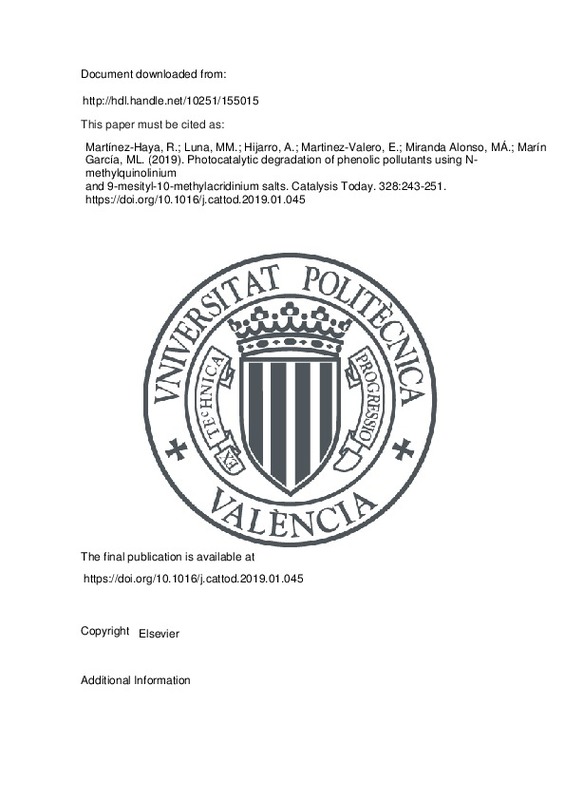JavaScript is disabled for your browser. Some features of this site may not work without it.
Buscar en RiuNet
Listar
Mi cuenta
Estadísticas
Ayuda RiuNet
Admin. UPV
Photocatalytic degradation of phenolic pollutants using N-methylquinolinium and 9-mesityl-10-methylacridinium salts
Mostrar el registro sencillo del ítem
Ficheros en el ítem
| dc.contributor.author | Martínez-Haya, Rebeca
|
es_ES |
| dc.contributor.author | Luna, M. M.
|
es_ES |
| dc.contributor.author | Hijarro, A.
|
es_ES |
| dc.contributor.author | Martinez-Valero, E.
|
es_ES |
| dc.contributor.author | Miranda Alonso, Miguel Ángel
|
es_ES |
| dc.contributor.author | Marín García, Mª Luisa
|
es_ES |
| dc.date.accessioned | 2020-11-13T04:33:06Z | |
| dc.date.available | 2020-11-13T04:33:06Z | |
| dc.date.issued | 2019-05-15 | es_ES |
| dc.identifier.issn | 0920-5861 | es_ES |
| dc.identifier.uri | http://hdl.handle.net/10251/155015 | |
| dc.description.abstract | [EN] The photodegradation of a mixture of phenolic pollutants including: phenol (P), orto-phenylphenol (OPP), 2,4,6-trichlorophenol (TCP) and pentachlorophenol (PCP) was accomplished using two organic cationic photocatalysts, namely N-methylquinolinium (NMQ(+)) and 9-mesityl-10-methylacridinium (Mes-Acr-Me+) salts, due to their singular photophysical and redox properties. On one hand, NMQ+ exhibits more energetic excited states and accordingly more favorable redox potentials than Mes-Acr-Me+; on the other hand, NMQ(+) absorption reaches only up to 380 nm, while Mes-Acr-Me+ extends in the visible up to 480 nm. Evaluation of the efficiency of both photocatalysts, revealed that the highest level of photodegradation was achieved when they were employed at 20% mol. Specifically, with NMQ(+), removal of the pollutants was completed within 24 h of irradiation. Even more, irradiation time could be shortened from 24 to 8 h, since high levels of removal were already achieved (93%, 100%, 100% and 82% for P, OPP, TCP and PCP, respectively). Albeit, Mes-Acr-Me+ was not as effective, and best results were obtained using 20% mol upon 24 h of irradiation. Under these conditions, removal of PCP was 80%, while TCP was 40%, OPP 30% and P resulted in the most recalcitrant contaminant with only 10% of removal. Next, NMQ(+) and Mes-Acr-Me+ were separately supported onto Zeolite Y, an inert inorganic support (Y-NMQ(+) and Y-Mes-Acr-Me+), and elemental analyses revealed a loading of ca. 13% and 15% weight for NMQ(+) and Mes-Acr-Me+, respectively. Upon heterogenization, in the case of Y-NMQ(+), the extent of removal was lower than the one achieved in the homogeneous photodegradations. On the contrary, performance of Y-Mes-Acr-Me+ improved, because of its enhanced photostability; thus, upon 46 h irradiation, 98%, 80%, 40% and 26% for PCP, TCP, OPP and P, respectively, was achieved. Moreover, their efficiency was maintained upon second use. Steady-state and time-resolved fluorescence quenching revealed that every pollutant was able to quench the singlet excited state of both 1(NMQ(+))* and 1(Mes-Acr-Me+)*, with kinetic rate constants in the order of the diffusion limit. Thus, Type I photooxidation happening through the singlet excited state of either photocatalyst was the main operating process in the photodegradation of the studied pollutants. | es_ES |
| dc.description.sponsorship | Financial support from Spanish Government (Grant SEV-20160683) is gratefully acknowledged. Financial support from VLC/Campus. R. Martinez-Haya thanks financial support for a predoctoral contract from Apadrina la Ciencia Association and Ford Espana/Ford Motor Company Fund. | es_ES |
| dc.language | Inglés | es_ES |
| dc.publisher | Elsevier | es_ES |
| dc.relation.ispartof | Catalysis Today | es_ES |
| dc.rights | Reconocimiento - No comercial - Sin obra derivada (by-nc-nd) | es_ES |
| dc.subject | Electron transfer | es_ES |
| dc.subject | Photocatalysis | es_ES |
| dc.subject | Singlet excited state | es_ES |
| dc.subject | Steady-state fluorescence | es_ES |
| dc.subject | Time-resolved fluorescence | es_ES |
| dc.subject.classification | QUIMICA ORGANICA | es_ES |
| dc.title | Photocatalytic degradation of phenolic pollutants using N-methylquinolinium and 9-mesityl-10-methylacridinium salts | es_ES |
| dc.type | Artículo | es_ES |
| dc.type | Comunicación en congreso | es_ES |
| dc.identifier.doi | 10.1016/j.cattod.2019.01.045 | es_ES |
| dc.relation.projectID | info:eu-repo/grantAgreement/MINECO//SEV-2016-0683/ | es_ES |
| dc.rights.accessRights | Abierto | es_ES |
| dc.contributor.affiliation | Universitat Politècnica de València. Departamento de Química - Departament de Química | es_ES |
| dc.description.bibliographicCitation | Martínez-Haya, R.; Luna, MM.; Hijarro, A.; Martinez-Valero, E.; Miranda Alonso, MÁ.; Marín García, ML. (2019). Photocatalytic degradation of phenolic pollutants using N-methylquinolinium and 9-mesityl-10-methylacridinium salts. Catalysis Today. 328:243-251. https://doi.org/10.1016/j.cattod.2019.01.045 | es_ES |
| dc.description.accrualMethod | S | es_ES |
| dc.relation.conferencename | 10th European Meeting on Solar Chemistry and Photocatalysis: Environmental Applications (SPEA10) | es_ES |
| dc.relation.conferencedate | Junio 04-08,2018 | es_ES |
| dc.relation.conferenceplace | Almería, España | es_ES |
| dc.relation.publisherversion | https://doi.org/10.1016/j.cattod.2019.01.045 | es_ES |
| dc.description.upvformatpinicio | 243 | es_ES |
| dc.description.upvformatpfin | 251 | es_ES |
| dc.type.version | info:eu-repo/semantics/publishedVersion | es_ES |
| dc.description.volume | 328 | es_ES |
| dc.relation.pasarela | S\404816 | es_ES |
| dc.contributor.funder | Apadrina la Ciencia | es_ES |
| dc.contributor.funder | Ford Motor Company Fund and Community Services | es_ES |
| dc.contributor.funder | Universitat Politècnica de València | es_ES |
| dc.contributor.funder | Ministerio de Economía y Competitividad | es_ES |







![[Cerrado]](/themes/UPV/images/candado.png)

